Keeping a hummingbird feeder in the garden can bring more appearance to this tiny beauty and make it a heavenly place. But the most irritating problem that happens, in this case, is the appearance of woodpeckers who are attracted by the Hummingbird feeder.
That’s why many of you are looking for some ways to keep woodpeckers off Hummingbird feeders. Well, woodpeckers can be attracted to sweet nectar and cause disruptions.
In this concise guide, we will explore effective strategies such as providing alternatives, using physical barriers, modifying feeders, creating a woodpecker-friendly habitat, and following best practices.
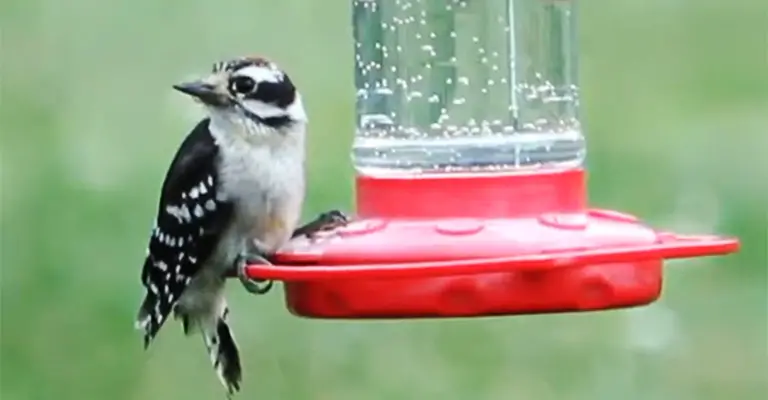
Woodpecker Behavior and Attraction to Feeders
It is essential to understand woodpeckers’ behavior in this context so that you can get rid of them easily and permanently. In this context, the following factors matter the most.
Why Woodpeckers Are Attracted to Hummingbird Feeders?
Woodpeckers are opportunistic feeders and are often attracted to the sweet nectar found in hummingbird feeders. The sugary liquid serves as a readily available food source, offering them a quick energy boost.
The bright colors of the feeders may also catch their attention, leading them to investigate and potentially feed from the ports.
Woodpecker Feeding Habits and Preferences
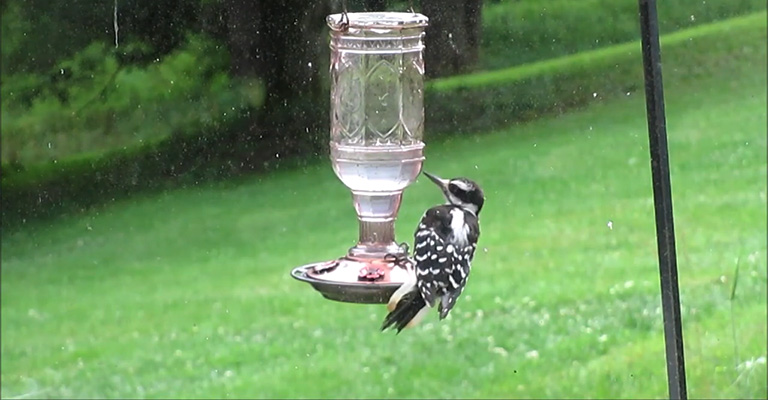
Woodpeckers have specialized adaptations for extracting insects from wood, such as their strong beaks and long tongues. While they primarily rely on insects for sustenance, they are known to supplement their diet with other food sources, including fruits, nuts, and sap.
The availability of nectar from hummingbird feeders can be an appealing alternative for woodpeckers, particularly during periods when their preferred food sources may be scarce.
Impact of Woodpecker Presence on Hummingbird Feeding
The presence of woodpeckers at hummingbird feeders can have several implications for hummingbird feeding behavior. Firstly, woodpeckers are larger and more aggressive birds compared to hummingbirds.
Their presence may intimidate or deter hummingbirds from approaching the feeders, disrupting their feeding patterns.
Additionally, woodpeckers may consume a significant amount of nectar, potentially depleting the food source for the hummingbirds and causing the need for more frequent refilling of the feeders.
Understanding woodpecker behavior and their attraction to hummingbird feeders is essential in finding effective solutions to keep them away.
In the following sections, we will explore various strategies and techniques to discourage woodpeckers from accessing the feeders and ensure a more harmonious feeding environment for both woodpeckers and hummingbirds.
Creating Woodpecker-friendly Alternatives

This must be the best solution to protect your hummingbird feeder from the woodpecker. You need to create some Woodpecker-friendly alternatives. Here’s how you can do that.
Suet Feeders as an Alternative Food Source for Woodpeckers
Suet feeders are specially designed to hold blocks or cakes of suet, a high-energy food made from animal fat. Woodpeckers are particularly fond of suet due to its nutritional value and the ease with which they can cling to the feeder and peck at the suet.
Introducing a suet feeder in your yard provides woodpeckers with a suitable food source that mimics their natural foraging behavior.
Tips for Selecting and Placing a Suet Feeder
When choosing a Suet feeder, opt for sturdy designs that can withstand the pecking and clinging behavior of woodpeckers. Look for feeders with metal cages or grids that hold the suet securely, preventing it from falling out easily.
Place the suet feeder in a location away from hummingbird feeders, ensuring it is easily accessible to woodpeckers while keeping it at a safe distance from potential predators.
To increase the attractiveness of the suet feeder to woodpeckers, consider offering suet with added ingredients like insects or fruits. This can entice woodpeckers further and provide them with a diverse and nutritious diet.
Other Food Options to Consider for Woodpeckers
While suet is a popular choice, woodpeckers have varied dietary preferences. In addition to suet, you can also provide woodpeckers with other food options.
Nuts, such as peanuts or tree nuts, are a great choice as they offer a good source of fats and proteins. Insects, such as mealworms or live larvae, can be offered either through specialized feeders or by creating an insect-rich habitat in your yard.
Fruits, like sliced apples or oranges, can also attract woodpeckers, particularly during the fruit-bearing season.
By offering a range of woodpecker-friendly food sources, you create an environment that meets their dietary needs and helps steer them away from the hummingbird feeders.
Remember to monitor and replenish the food regularly to ensure a consistent and reliable supply for the woodpeckers.
Using Physical Barriers and Deterrents
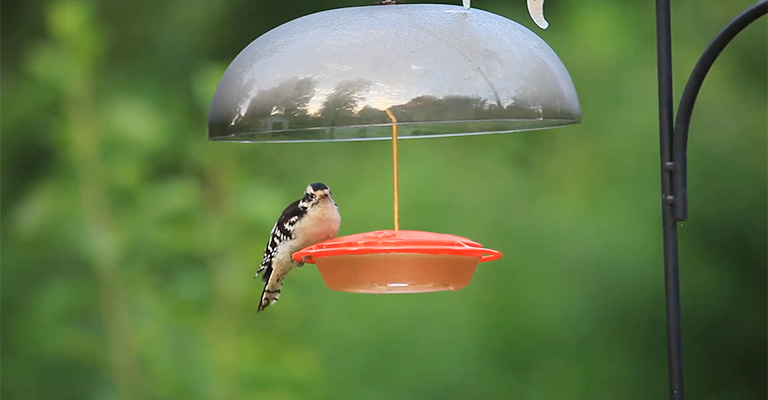
Though we never encourage you to make some physical barrier for the woodpecker, still, some of you need this to do when the woodpecker’s number is so high.
Bafflers or Cone Guards to Prevent Woodpecker Access
Bafflers and cone guards are physical barriers that create obstacles for woodpeckers, preventing them from reaching the hummingbird feeders.
Bafflers are typically dome-shaped devices that are placed above the feeder, while cone guards are cone-shaped and positioned below the feeder.
These barriers can be made of various materials, such as metal or plastic, and serve as effective deterrents by blocking woodpeckers’ access to the feeder ports.
The benefits of using bafflers or cone guards include protecting the nectar in the feeders from woodpecker interference and allowing hummingbirds to feed undisturbed.
These barriers also provide a visual signal to woodpeckers that the feeders are inaccessible, encouraging them to seek alternative food sources.
Installation and Placement of Bafflers or Cone Guards
When installing bafflers or cone guards, it’s important to consider their size and positioning. Ensure that the baffler or cone guard is large enough to completely cover the feeder, preventing woodpeckers from reaching it.
The material should be sturdy and durable to withstand woodpecker attempts to dislodge or bypass the barriers.
For bafflers, position them above the feeder at a height that is difficult for woodpeckers to reach or cling onto. This can be achieved by suspending the baffler from a pole or hanging it from a tree branch.
Cone guards, on the other hand, should be positioned below the feeder, extending outward to create a physical barrier.
Regularly inspect and maintain the bafflers or cone guards to ensure they remain securely in place and free from any damage or obstructions. This will ensure their continued effectiveness in deterring woodpeckers.
Reflective Objects and Moving Items to Scare Woodpeckers
In addition to physical barriers, visual deterrents can be employed to discourage woodpeckers from approaching the hummingbird feeders. Reflective objects, such as strips of aluminum foil or old CDs, can be hung near the feeders.
The sunlight reflecting off these objects creates flashes and movements that can startle woodpeckers and make them wary of the area.
Other moving items, like wind chimes or streamers, can also be effective in deterring woodpeckers. The motion and noise generated by these objects create an unfamiliar and potentially threatening environment for the birds.
Experiment with different visual deterrents and their placement to find the most effective combination for your specific situation. Regularly inspect and adjust them as needed to maintain their effectiveness.
Hummingbird Feeder Modifications
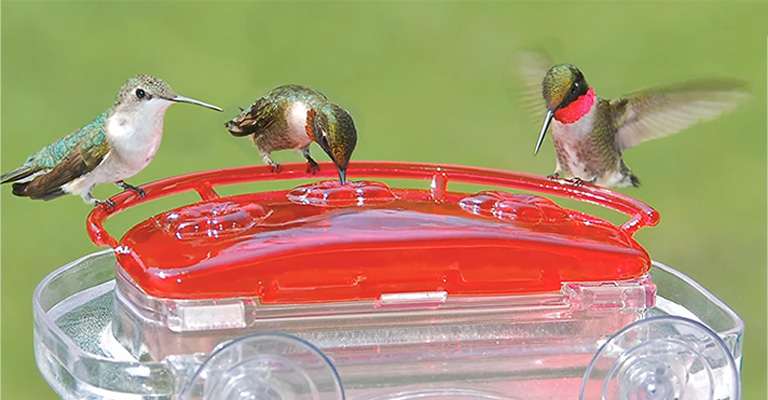
You can also modify your Hummingbird feeders which helps get rid of the woodpeckers. In this case, you can apply the following steps.
Choosing Feeders With Smaller Perches
Woodpeckers prefer feeders with larger perches that can accommodate their size and feeding behavior.
By selecting feeders with smaller perches, you create an environment that is less accommodating to woodpeckers while still allowing hummingbirds to access the nectar.
Look for feeders designed specifically with smaller perches or consider modifying existing feeders by reducing the size of the perches.
Smaller perches make it more challenging for woodpeckers to cling onto the feeder and access the nectar ports.
This modification helps create a barrier for woodpeckers while ensuring that hummingbirds, with their delicate feet, can comfortably feed from the ports.
Diluting the Nectar Mixture
Woodpeckers are attracted to the sweet nectar found in hummingbird feeders. By diluting the nectar mixture, you can make it less concentrated and less appealing to woodpeckers while still providing a suitable food source for hummingbirds.
Adjusting the nectar concentration helps strike a balance between attracting hummingbirds and deterring woodpeckers.
A common dilution ratio is 4 parts water to 1 part sugar. However, you can increase the water-to-sugar ratio slightly to make the nectar less enticing to woodpeckers.
Experiment with different ratios to find the optimal dilution that still attracts hummingbirds while reducing woodpecker interest.
Balancing Modifications
While implementing modifications to deter woodpeckers, it’s important to ensure that the feeders still fulfill their primary purpose of attracting and providing sustenance for hummingbirds.
Continuously monitor the feeding activity of hummingbirds and make adjustments as needed to maintain their access to the nectar.
Regularly observe the feeders to ensure that hummingbirds are still able to feed comfortably despite the modifications.
If you notice a decline in hummingbird activity, reevaluate the feeder modifications and make any necessary adjustments to strike the right balance.
Remember, the goal is to create an environment that discourages woodpeckers while preserving the feeding opportunities for hummingbirds.
By carefully balancing the modifications, you can achieve a harmonious feeding experience for both bird species.
Creating a Woodpecker-friendly Habitat
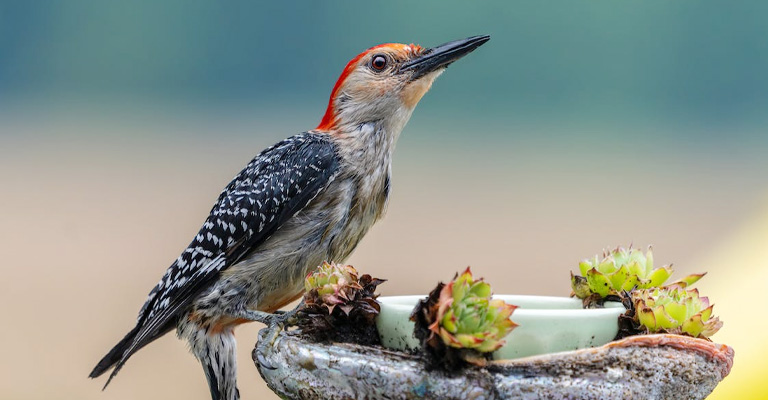
Woodpeckers require specific habitat conditions to thrive, including access to suitable nesting sites, foraging opportunities, and territorial space.
By providing suitable habitats, you can encourage woodpeckers to establish their presence in your yard and reduce their reliance on hummingbird feeders for food.
Woodpeckers are cavity nesters, meaning they excavate holes in dead or decaying trees to create nesting sites. These cavities serve as sheltered spaces for breeding and raising their young.
Offering suitable nesting opportunities is crucial for attracting woodpeckers and providing them with the necessary habitat elements for their survival.
Providing Alternative Nesting Sites and Perching Spots
To create alternative nesting sites and perching spots for woodpeckers, consider installing nest boxes specifically designed for woodpecker species. These boxes should mimic natural tree cavities in terms of size, entrance hole diameter, and insulation.
Place them in strategic locations within your yard, such as near tree trunks or in areas with suitable habitat features.
In addition to nest boxes, provide perching spots for woodpeckers. Install dead tree trunks or branches in your yard to simulate natural perching and foraging structures.
These perching spots can serve as hunting grounds for insects and attract woodpeckers away from the hummingbird feeders.
Managing Dead Trees or Rotting Wood
Woodpeckers have a particular affinity for dead trees and rotting wood, as they provide an abundant source of insect prey. If you have dead or decaying trees in your yard, consider leaving them in place (if safe to do so) to attract woodpeckers.
These trees can become valuable foraging sites and nesting opportunities, ultimately diverting woodpeckers’ attention from the hummingbird feeders.
Regularly inspect and manage the dead trees or rotting wood to ensure their stability and safety. Remove any hazardous branches or sections that may pose a risk to people or property.
Strike a balance between creating a woodpecker-friendly habitat and maintaining a well-maintained and safe environment.
By providing suitable habitat, including alternative nesting sites and perching spots, as well as managing dead trees or rotting wood, you can create an environment that supports woodpecker populations and encourages them to forage and nest away from hummingbird feeders.
Additional Tips and Best Practices
There are a few more tips that also work in this case. Make sure to check the following tips.
Maintenance and Cleanliness of Feeders
Regular maintenance and cleanliness of the feeders are essential for minimizing woodpecker attraction. Clean the feeders thoroughly on a regular basis, removing any accumulated residue or mold.
This prevents the buildup of bacteria that can attract woodpeckers and cause potential health issues for the birds.
Inspect the feeders for any signs of damage or wear. Replace worn-out parts or broken feeders to ensure they function properly and do not provide easy access to woodpeckers.
By maintaining the feeders in good condition, you can discourage woodpecker interest and ensure a safe and inviting feeding environment for hummingbirds.
Local Regulations and Laws Regarding Bird Feeding
Before implementing any bird-feeding practices, it’s crucial to understand the local regulations and laws regarding bird feeding in your area.
Some regions may have specific guidelines or restrictions to ensure the well-being of wildlife and prevent the spread of diseases.
Familiarize yourself with these regulations to ensure your feeding practices align with the legal requirements and promote responsible bird feeding.
Bird-friendly Practices While Keeping Woodpeckers Away
While the focus is on deterring woodpeckers from hummingbird feeders, it’s essential to maintain an overall bird-friendly environment in your yard.
Encourage practices that benefit all bird species, including providing a reliable water source such as a birdbath, planting native flowers and shrubs that attract a variety of birds, and minimizing the use of pesticides that can harm both woodpeckers and other beneficial insects.
Promote a diverse and healthy ecosystem that supports the natural behavior and needs of birds. By providing a range of food sources, nesting opportunities, and habitat elements, you can create an environment that benefits woodpeckers and other bird species while reducing the woodpeckers’ reliance on hummingbird feeders.
Woodpecker Deterrence Strategies
| Deterrence Strategy | Description |
| Providing alternative food sources | Introducing suet feeders or offering nuts, insects, or fruits as woodpecker-friendly food alternatives. |
| Using physical barriers | Installing bafflers or cone guards above or below feeders to create physical barriers against woodpeckers. |
| Modifying feeders | Choosing feeders with smaller perches and diluting nectar mixture to make it less appealing to woodpeckers. |
| Creating a woodpecker-friendly habitat | Providing nest boxes, perching spots, and managing dead trees or rotting wood to attract woodpeckers away from feeders. |
| Proper maintenance and cleanliness | Regularly cleaning and maintaining feeders to minimize woodpecker attraction and ensure a safe feeding environment. |
| Understanding local regulations | Familiarizing oneself with local laws and regulations regarding bird feeding to ensure compliance. |
| Encouraging bird-friendly practices | Promoting bird-friendly practices such as providing water sources and planting native flora to support overall bird populations. |
FAQs
It is generally not recommended to use repellents or chemicals to deter woodpeckers. These substances may be harmful to birds and can have negative effects on their health.
It is best to focus on non-toxic and environmentally friendly deterrents and modifications.
While scarecrows or owl decoys might temporarily startle woodpeckers, they are unlikely to provide a long-term solution. Woodpeckers are intelligent birds and can quickly become accustomed to static objects.
It’s best to focus on more dynamic deterrents like visual or auditory deterrents.
Different woodpecker species may vary in their attraction to hummingbird feeders. However, many woodpeckers, such as the Northern Flicker or Red-bellied Woodpecker, can show interest in the sweet nectar.
Implementing the suggested strategies can help deter woodpeckers regardless of the species.
The time it takes to deter woodpeckers can vary depending on several factors, including the persistence of the woodpeckers and the effectiveness of the implemented strategies.
Some woodpeckers may be deterred relatively quickly, while others may take longer to change their behavior. Consistency and patience are key.
Implementing deterrents to keep woodpeckers away from hummingbird feeders should not negatively impact other bird species. The strategies discussed are focused on redirecting woodpeckers to alternative food sources and creating a woodpecker-friendly habitat.
This allows other birds, including hummingbirds, to continue accessing the feeders undisturbed.
Conclusion
Deterring woodpeckers from hummingbird feeders requires a multi-faceted approach. You can simply implement strategies such as providing suet feeders, using physical barriers, modifying feeders, creating a woodpecker-friendly habitat, and following best practices.
These strategies will effectively help you create a harmonious feeding environment for hummingbirds while redirecting woodpeckers to their natural food sources.
Hopefully, you’ve got my point. Now let us know if you have any more tricks to get rid of woodpeckers and save the hummingbird feeder. We also love to learn about the new thing. That’s why we always wait to hear from you. Thank you for your support.